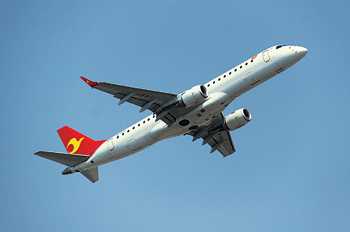INDIAN ARMED FORCES CHIEFS ON
OUR RELENTLESS AND FOCUSED PUBLISHING EFFORTS

SP Guide Publications puts forth a well compiled articulation of issues, pursuits and accomplishments of the Indian Army, over the years

I am confident that SP Guide Publications would continue to inform, inspire and influence.

My compliments to SP Guide Publications for informative and credible reportage on contemporary aerospace issues over the past six decades.
Tailwinds for Chinese Carriers
Embraer has forecast that China’s domestic carriers would need 950 regional jets with 30 to 120 seats in the next 20 years, accounting for 14 per cent of the global demand




The Aviat ion Industry Corporat ion of China has predicted that in the next 20 years, China will add 4,583 civilian aircraft, including 3,682 jumbo jets and 901 regional aircraft. By 2030, China’s share of the global aircraft fleet will increase from nine to 15 per cent. China’s fast expanding regional aviation market is attracting the attention of global aircraft makers, as it is expected to grow rapidly in the next few years with the government moving to tap its potential.
Bright Future
Guo Qing, Vice President of Embraer China (Marketing), has said that Embraer is “very optimistic” about the future development of China’s domestic regional aviation market, especially in the country’s underdeveloped regions. Recently, Embraer signed an agreement with the China Development Bank (CDB) and the Leasing and China Southern Airlines (CSA) to sell 10 E190 aircraft to CSA, the country’s largest airline by fleet size. The new aircraft will be operated on routes in the Northwestern Xinjiang Uygur regions.
The expansion into the hinterland came after the government decided to abolish airport construction fees for airlines operating domestic short-haul flights. This is expected to give fillip to the aviation market in China’s economically less-developed regions, especially the central and western regions.
Government Push
The decision of the government to exempt fees included eight models of regional aircraft, including Embraer’s ERJ series. These aircraft cover over 800 air routes, connecting nearly 130 airports. “The move reflects a clear government stance on regional aviation market development,” said Guo, noting that the policy would bring residents in remote regions wider access to aviation services with lower travel costs.
The Civil Aviation Administration of China (CAAC) is expecting the new policy to benefit almost 10 million passengers each year. Previously, passengers would pay 10 yuan ($1.5) as airport construction fees for each trip on the flights with the eight aircraft models.
Embraer has forecast that China’s domestic carriers would need a total of 950 regional jets with 30 to 120 seats in the next 20 years, accounting for 14 per cent of the global demand during the period, the second only after Europe. Presently, nearly 100 Embraer aircraft are being used on air routes in China, while the company will deliver 29 E190 jets in the coming years.
Realising the potential that exists, Embraer is continuing to bet big on China’s regional aviation market. The continued expansion of airports in West China is very likely to drive up demand for regional jets from short-haul airlines. The CAAC is planning to build 32 new airports, rebuild and expand 24 others, as well as relocate nine more in West China in the 12th Five Year Plan period (2011-15).
Xinjiang, where Embraer’s newly sold E190 jets would be flying, for instance, will build six more airports in the next five years, according to local aviation authorities. There are currently 16 airports in Xinjiang.
Right Sizing
Some of the airlines have in the past been using large aircraft to tap the emerging markets and have realised that they are not suitable aircraft. It has led to skewed development and the lack of cooperation between mainline carriers and regional airlines has added to the problems. The issue that needs to be resolved is networking the routes effectively as presently, 60 per cent of the routes are in the range of 800 to 2,200 km. As the hinterland airports emerge, this is likely to change more in favour of regional airlines. Also regional airlines are acting as feeders to mainline carriers. Four main regional hubs are Urumqi, Xian, Kunming and Tianjin. From these hubs, trunk carriers take passengers to cities further out of the region.
Some of the established regional airlines are now subsidiaries of mainline carriers, e.g. Shandong Airlines (Air China), Yunnan Airlines (China Eastern), Xinjiang Airlines and Guizhou Airlines (China Southern).
First Private Regional Airline
China Express Airlines, also known as Huaxia Airlines, is China’s first private regional airline. The airline was established in May 2006 and is owned by a consortium consisting of Cathay Fortune (40 per cent), High Zero (25 per cent), Tampines International (24 per cent) and others (11 per cent). It is based in Guiyang, Guizhou. It provides services using Bombardier CRJ200 and Bombardier CRJ900 aircraft. As of April 2015, China Express fleet consisted of four CRJ200 and 14 CRJ900 (19 orders are pending).
Tianjin Airlines, Networking China
Formerly Grand China Express Air, Tianjin is a regional airline headquartered in Tianjin in China operating domestic scheduled passenger and cargo flights out of Tianjin Binhai International Airport. It is based in the economic centre of Bohai Rim. Aggressively serving development of regional economic construction and committed to providing easy and convenient air travel for passengers, Tianjin is emerging as a new force in China’s civil aviation market.
The biggest opportunity may come from the growth of regional aviation in China, as airlines expand into smaller cities and begin point-to-point service between mid-size cities
The airline was established in 2004 in an effort to merge the major aviation assets of Hainan Airlines, China Xinhua Airlines, Chang’an Airlines and Shanxi Airlines, and received its operating licence from the Civil Aviation Administration of China in 2007. Scheduled flights were launched under the brand name Grand China Express Air, using 29/32-seat Dornier 328-300 jets. At that time, the company was China’s largest regional airline operating on 78 routes linking 54 cities. On June 10, 2009, the company was renamed as Tianjin Airlines. The airline is flying on over 450 routes linking at least 90 cities, garnering more than 90 per cent of the domestic regional aviation market.
Tianjin Airlines fleet that consists of 85 aircraft with an average age of 4.1 years has on its inventory 12 Airbus A320, 23 Embraer ERJ 145 and 50 Embraer 190. Additionally, Tianjin Airlines operates 11 Dornier 328 aircraft which are owned by Hainan Airlines. Tianjin Airlines, China’s biggest regional airline already has a large fleet of E190s and has a conditional order for 20 of the second-generation E-Jets. Within the next decade or so, China could become Embraer’s biggest market. This will help diversify its revenue base away from the US while offering a big opportunity for margin-accretive growth.
Juneyao Airlines
Juneyao is a regional airline based in Changning district, Shanghai, China, operating domestic services out of the two Shanghai airports Hongqiao and Pudong. The company was founded in 2005 as a subsidiary of Juneyao Group. As of August 2014, the Juneyao Airlines fleet consists of 36 aircraft with an average age of 3.1 years. It has 32 Airbus A320-200 and four Airbus A321-200.
China Eastern Airlines is an airline headquartered at the Shanghai Hongqiao International airport in Changning district, Shanghai. It is a major Chinese airline operating international, domestic and regional routes. Its main hubs are at Shanghai Pudong International Airport and Shanghai Hongqiao International Airport with secondary hubs at Kunming Changsui International Airport and Xi’an Xianyang International Airport. China Eastern Airlines is China’s second largest carrier by passenger numbers. China Eastern and its subsidiary Shanghai Airlines are members of SkyTeam. In 2014, China Eastern Airlines carried 83.08 million domestic and international passengers with an average load factor of 73 per cent.
The biggest opportunity may come from the growth of regional aviation in China, as airlines expand into smaller cities and begin point-to-point service between midsize cities.





